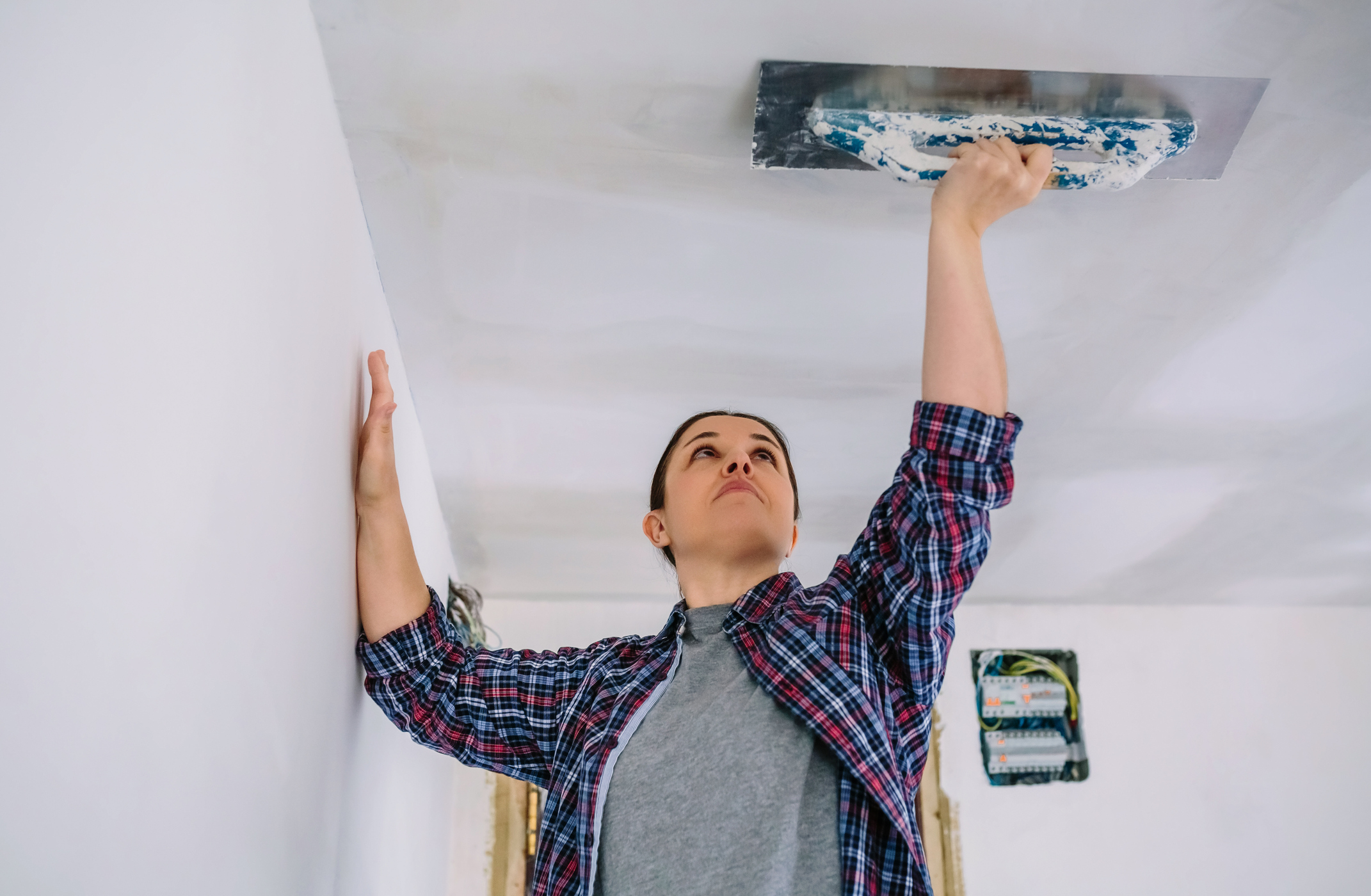
Wondering how to repair a plaster ceiling? There are a few different ways you can do it. Which method you use ultimately comes down to the cause of the damage and how extensive it is (and sometimes the structure of your ceiling, but more on that later), so it’s always best to start with a little investigation.
The good news is that in most cases, it’s relatively simple to restore the surface to its smooth former glory, meaning that you won't have to plaster a ceiling in its entirety.
‘You can usually scrape away any cracks or holes in the plaster using a putty knife and then repaint the area. Another option is to patch up smaller areas that are damaged using drywall compound or spackle. If the damage is particularly severe, replacing the ceiling altogether might be the best route to go down’, says Luke Lee, co-founder of Ever Wallpaper.
In this case, learning how to patch a drywall ceiling or how to hang a drywall ceiling can prove useful.
How to repair a plaster ceiling
Before you start fixing, it’s worth establishing the structure of your plaster ceiling, and find out, perhaps, why your ceiling is cracking. Moisture could be the cause, in which case you’ll need to know how fix a ceiling with water damage. Modern building methods have seen traditional lath-and-plaster ceilings replaced by drywall or plasterboard that’s then skimmed with a thin layer of plaster to achieve the same smooth surface. Repair methods will vary depending on the type of plaster ceiling you have in your home.
Whether the damage has come as a result of fixing a ceiling leak, shoddy DIY work, simple wear and tear or something a little more serious, we’ve put together an easy guide to help you recognize the warning signs and know how to repair a plaster ceiling accordingly.
Track down the cause of the problem
Before you start any repair work on your ceiling, you’ll need to work out what caused the damage in the first place. Sometimes it’s obvious; unsightly yellow stains are a clear sign of a moisture problem, so you’d be best off researching how to fix a ceiling with water damage for example. Other times it can be a little trickier.
Design expertise in your inbox – from inspiring decorating ideas and beautiful celebrity homes to practical gardening advice and shopping round-ups.
The cause of a crack in a plaster ceiling is more than likely cosmetic, occurring due to changes in temperature or as a result of DIY work, for example. However, it’s better to investigate.
‘While minor cracks are usually nothing to worry about, thicker ones (anything more than 1/10 of an inch) can be a warning sign that structural problems may be afoot. In this case, you should bring in a professional to inspect in more detail’, says Ash Reed, interiors expert at Living Cozy.
If the crack in question traverses the wall as well as the ceiling, you will want to know what causes cracks in walls to help solve the problem.
Only once you’ve established the cause – and resolved any issues – are you in a position to think about how to repair a plaster ceiling.
Protect the area
Regardless of the extent of repair work necessary, you’ll need to wear protective gear including a face mask and goggles, particularly when working with old plaster. Cover walls and furniture with plastic and lay down drop cloths so any dust and scrapings can be easily cleaned up afterwards.
How to repair cracks and holes in a plaster ceiling
Cosmetic issues such as repairing nail holes and gouges caused by DIY work and fixing ceiling cracks that are fine in a plaster ceiling are relatively easy to deal with. It may seem counterintuitive, but the best thing you can do is to make the crack slightly wider. ‘This will ensure you get enough easy sand into the crack for a substantial strong fill’, explains Nicholas Smacchia from Westchester-based company, Plastering by Nicholas.
Ensure you have brushed out any debris before applying joint compound or filler with a putty knife, scraping off the excess as you go. After applying several thin layers, let it dry and sand the area to create a flat, smooth finish. Then prime and paint to match the wall.
For wider cracks, consider applying mesh or fiberglass tape over it before spreading joint compound over the top and smoothing out. This same method works for small holes, too.
How to repair a sagging plaster ceiling
Typically found in older homes, traditional lath-and-plaster ceilings are formed by nailing strips of wood or metal mesh (referred to as laths) to the ceiling joists to form a strong base, then adding layers of plaster on top.
Over time, plaster can dry out, weaken and lose its holding strength, and the laths can start to pull away. The first sign of this is sagging or bulging plaster. We’d advise calling in a professional for a job like this, however, it you want to attempt it yourself, here’s how the DIY experts at B&Q advise you do it:
‘Prop up the sagging plaster using a flat piece of chipboard or plywood nailed to a length of 38mm-square timber. This should reach from the floor to the ceiling. Lift the floorboards in the room above and vacuum between the joists over the bulge to collect up loose plaster.
'Mix fairly runny boding undercoat plaster and pour it over the damaged area to replace the broken plaster. Leave the supporting prop in place until the plaster has dried and bonded to the laths’.
You can then either remove the old plaster or leave it in place and reface the entire area with a new drywall.
Does water damaged plaster need replacing?
It depends. If modern plastering applications have been used, you’ll need to assess whether the drywall underneath has suffered extensive water damage. Indicators include large holes or sagging in the ceiling, as well as mold and discoloration.
‘In this case, the ceiling would need to be fully replaced, including structural elements such as beams’, says Adam Graham, construction analyst at Fixr.
Repairs aren’t usually that drastic, however. Assuming the water damage is surface-level and the laths are still intact, you can simply replaster over the top.
Can you repair part of the ceiling?
If only a small part of your ceiling is affected, you can make a simple repair with a plasterboard or drywall patch. Cut out the damaged area of plaster, then use drywall to patch it, securing it in place with drywall screws.
‘It’s a good idea to take off the old plaster before you buy the plasterboard to make a repair patch. Then you can choose the thickness closest to the depth of your plaster’, say the DIY experts at B&Q.
Can I fix my own ceiling?
It depends on the extent of the repair work required and the finish you’re expecting. Minor issues such as cracks and water damage are easy enough to DIY, however, larger fixes should be dealt with by professionals to ensure the ceiling is repaired to recommended safety standards.
‘Whether you decide to do the work yourself or hire an expert, it's important to address repair issues as soon as possible. Leaving them unaddressed for too long can lead to costly problems further down the line’, says Luke Lee.

For 10 years, Tara King worked as a Content Editor in the magazine industry, before leaving to become freelance, covering interior design, wellbeing, craft and homemaking. As well as writing for Ideal Home, Style at Home, Country Homes & Interiors, Tara’s keen eye for styling combined with a passion for creating a happy – and functional – family home has led to a series of organization and cleaning features for H&G.
